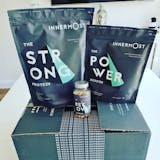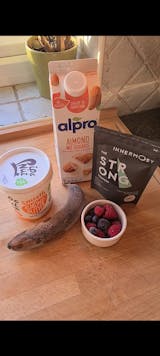You may have heard that we recently held a Strength Training 101 webinar. Within this webinar, we talked all things strength training, from its benefits to how to get started with weight training. One thing we touched heavily upon were some common strength training myths and why you should stop believing them. If you missed our webinar and would like to catch up, check out the video below. But if you're short of time, read on for a run down of some of the most common strength training misconceptions.
What Is Strength Training?
Strength training, also called resistance or weight training, is a type of exercise that aims to make your muscles stronger and improve endurance. It typically involves using weights or resistance to achieve this. The main purpose of strength training is to improve your muscles' ability to produce force. This leads to increased muscle mass, better tone, and improved overall fitness. When you use external resistance like weights or resistance bands, it causes tension in your muscle fibres and microscopic tears. During the recovery phase, your body starts repairing these tears by creating new proteins and muscle fibres, which is what makes your muscles stronger.
4 Common Strength Training Myths:
The buzz around strength training doesn’t come without common misconceptions and myths, and I’m sure you have heard many reasons as to why it might hinder your health or just not be of benefit to you.
1. Strength training can make women bulky
This myth is so prevalent within society but seems to be slowly decreasing. Actually, a balanced strength training program with a good diet gives you a lean and toned physique. Numerous studies have shown that genetic and hormonal differences between ourselves and our male counterparts, such as testosterone levels, make gaining large amounts of muscle a greater challenge for women. Studies have also shown that strength training in women tends to lead to an increase in lean body mass, which is associated with improved metabolism and fat loss and contributes to a toned and athletic appearance rather than bulkiness.
2. Cardio is better for fat loss
Strength training actually plays a significant role in shedding fat by boosting metabolism and promoting lean muscle mass. A 2019 study by the Institute of Sports Sciences found that muscle is more active than fat - a pound of muscle can burn anywhere from 10 to 20 calories a day, while a pound of fat burns only 2 to 5 calories a day. A 2020 study published in the Journal of Sports Science also shows that your metabolic rate is increased for up to 72 hours after strength-training exercise. This means that you’re still burning additional calories hours and even days after your workout. Not to mention, combining strength training with cardio creates a more exciting and enjoyable fitness routine than just doing cardio alone.
3. Strength training isn't for older people:
It's commonly believed that strength training can injure older people, but research suggests strength training is actually a great activity for older adults. Research shows that after the age of 30, adults can lose 3-5% of muscle mass per decade, so strength training helps to combat this age-related muscle loss. It also helps to maintain bone density, improve joint health, and enhances overall functional fitness. So strength training could actually help prevent age-related injury and promote a higher quality of life as we age.
4. Strength training is time consuming:
Lots of people think strength training takes up a lot of time but you can actually achieve effective strength training in short, focused workouts, even 30 to 45 minute workouts can yield significant results. In fact, according to the British Medical Journal, a period of between 30 to 60 minutes of strength training per week is all you need to reap the benefits of strength training. As cliché as it sounds, it's very much quality and consistency over quantity.
In terms of needing a gym, strength training can be a very versatile practice that you can do anywhere, living room, local park, or even the garden. The main key is completing more bodyweight exercises, and adding things like resistance bands.
Benefits of Strength Training
Now that we've unpacked some truths about strength training, we want to turn our attention to the science behind the holistic benefits that strength training provides.
1.Mental health:
Regarding our mental health, current research suggests regular strength training sessions reduce symptoms of both anxiety and depression regardless of age or health status. One way this occurs is through the release of hormones called endorphins which act as a natural mood enhancer and stress reliever, and are part of the reason why when you exercise you feel a little buzz. Our mood can also be improved by the feeling of accomplishment you get when you complete your strength-goals- like upping your squat by a few kg, holding a new yoga pose or just pushing yourself to do a few more reps.
On top of this, a systematic review that studied 754 adults showed a significant link between strength training and positive body image, including body satisfaction, appearance, and social anxiety around how you look.
2. Cognitive benefits:
A lesser known benefit of strength training is improved cognitive function and neuroprotective effects. Those who engage in strength training may have better brain health and protection against age-related cognitive decline. This is because strength training improves blood flow, reduces inflammation, and increases brain-derived neurotrophic factor (BDNF), which is basically what’s linked to memory and learning. Multiple studies have also pointed to other significant cognitive improvements after participating in strength training, like processing speed, memory, and executive function.
Executive function is like the CEO of your brain—it's the boss that helps you plan, organise, manage your emotions and get stuff done. It's what makes sure you remember to grab your keys before leaving the house, helps you follow a recipe, and stick to a schedule without procrastinating or binge-watching TV.
3. Physical strength:
It may seem like stating the obvious, but it’s an equally important benefit, and that’s your physical strength. As Shiv talked about earlier, as you progressively challenge your muscles with resistance, they get better at generating force by bringing in more muscle fibres after those microscopic tears. This allows you to lift heavier weights and perform more challenging exercises. This doesn't only mean the benefit is you can squat more or deadlift more, but also translates to completing more mundane tasks more easily like bringing the shopping in or climbing the stairs at work.
Strength training improves posture and reduces lower back pain by enhancing the strength and endurance of core muscles. When the muscles supporting the spine and lower back are strengthened through exercises like squats and deadlifts, they provide better support and stability. This, in turn, helps maintain a more upright posture and reduces the strain on the lower back, which alleviates that pain and improves your spine health.
4. Metabolic and chronic diseases:
According to the World Health Organization (WHO), strength training has been associated with a 20-30% reduction in the risk of chronic diseases like cardiovascular disease, type 2 diabetes and arthritis. This is because it’s been shown to improve insulin sensitivity, so your body is able to regulate your blood sugar levels more effectively. It’s been linked to improvements in blood pressure and cholesterol levels. It also improves joint function and overall mobility.
5. Better sleep:
Engaging in regular physical activity, including strength training, has been shown in research to improve sleep quality and duration. That research shows that 60% of people who weight train get an average of 7 hours or more of sleep per night. The exertion during workouts, coupled with the positive impact on stress levels, promotes more restful and rejuvenating sleep.
In summary, there are numerous myths surrounding strength training and if you're ever confused about anything you hear about it, you should do some research before disregarding weight training entirely, or simply get in touch on our website for some quick advice. Beyond physical benefits, strength training has many benefits for your overall health, from improving cognitive function to reducing the risk of chronic diseases, strength training enhances overall well-being. Embrace the power of short, focused workouts and discover the joy of achieving strength goals. Strengthen your body, elevate your mood, and foster a healthier, more fulfilling life through the enduring practice of strength training.
























